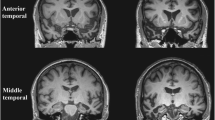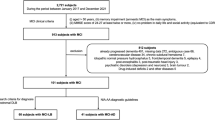Abstract
Introduction
Patients with type 2 diabetes mellitus (T2DM) have usually been found cognitive impairment associated with brain white matter (WM) abnormalities. However, findings have varied across studies, and any potential relationship with Alzheimer’s disease (AD) remains unclear. The aim of this study was to assess the whole-brain WM integrity of T2DM patients and to compare our findings with those of published AD cases.
Methods
In this study, we used diffusion tensor imaging (DTI) combined with tract-based spatial statistics (TBSS) to investigate whole-brain WM abnormalities in 48 T2DM patients and 48 healthy controls. The effects of age and gender were also evaluated.
Results
In our study, significantly decreasing FA and increasing MD and DA values (P<0.05) were found in some WM regions closely related to the default mode network (DMN), including cingulum, the right frontal lobe involving the right uncinate fasciculus (UF), bilateral parietal lobes involving the superior longitudinal fasciculus (SLF) and the inferior longitudinal fasciculus (ILF), and the right middle temporal gyrus (MTG) involving the UF and the ILF. We also found abnormalities in the thalamus involving the fornix (FX), anterior thalamic radiation (ATR), and posterior thalamic radiation (PTR). The damaged regions above are similar to those found in patients with AD, as reported in previous studies.
Conclusion
The present study not only provides useful information about the WM regions and tracts affected by T2DM but also offers insight into the underlying neuropathological process in T2DM patients and the relationship between T2DM and AD.



Similar content being viewed by others
Abbreviations
- T2DM:
-
Type 2 diabetes mellitus
- AD:
-
Alzheimer’s disease
- WM:
-
White matter
- DTI:
-
Diffusion tensor imaging
- TBSS:
-
Tract-based spatial statistics
- DMN:
-
Default mode network
- MTG:
-
Middle temporal gyrus
- UF:
-
Uncinate fasciculus
- SLF:
-
Superior longitudinal fasciculus
- ILF:
-
Inferior longitudinal fasciculus
- FX:
-
Fornix
- ATR:
-
Anterior thalamic radiation
- PTR:
-
Posterior thalamic radiation
- FA:
-
Fractional anisotropy
- MD:
-
Mean diffusivity
- DA:
-
Axial diffusivity
- RD:
-
Radial diffusivity
References
Moran C, Phan TG, Chen J, Blizzard L, Beare R, Venn A, Münch G, Wood AG, Forbes J, Greenaway TM, Pearson S, Srikanth V (2013) Brain atrophy in type 2 diabetes regional distribution and influence on cognition. Diabetes Care 36:4036–4042
Reijmer YD, van den Berg E, Ruis C, Kappelle LJ, Biessels GJ (2010) Cognitive dysfunction in patients with type 2 diabetes. Diabetes Metab Res Rev 26:507–519
Basser PJ, Mattiello J, LeBihan D (1994) MR diffusion tensor spectroscopy and imaging. Biophys J 66:259–267
Wai YY, Hsu WC, Fung HC, Lee JD, Chan HL, Tsai ML, Lin YC, Wu YR, Ying L, Wang JJ (2014) Tract-based spatial statistics: application to mild cognitive impairment. Biomed Res Int 2014:713079
Falvey CM, Rosano C, Simonsick EM, Harris T, Strotmeyer ES, Satterfield S, Yaffe K (2013) Macro- and microstructural magnetic resonance imaging indices associated with diabetes among community-dwelling older adults. Diabetes Care 3:677–682
Song SK, Sun SW, Ju WK, Lin SJ, Cross AH, Neufeld AH (2003) Diffusion tensor imaging detects and differentiates axon and myelin degeneration in mouse optic nerve after retinal ischemia. NeuroImage 20:1714–1722
Hsu JL, Chen YL, Leu JG, Jaw FS, Lee CH, Tsai YF, Hsu CY, Bai CH, Leemans A (2012) Microstructural white matter abnormalities in type 2 diabetes mellitus: a diffusion tensor imaging study. NeuroImage 59:1098–1105
Smith SM, Jenkinson M, Johansen-Berg H, Rueckert D, Nichols TE, Mackay CE, Watkins KE, Ciccarelli O, Cader MZ, Matthews PM, Behrens TE (2006) Tract-based spatial statistics: voxelwise analysis of multi-subject diffusion data. NeuroImage 31:1487–1505
Smith SM, Johansen-Berg H, Jenkinson M, Rueckert D, Nichols TE, Miller KL, Robson MD, Jones DK, Klein JC, Bartsch AJ, Behrens TE (2007) Acquisition and voxelwise analysis of multi-subject diffusion data with tract-based spatial statistics. Nat Protoc 2:499–503
Smith SM, Jenkinson M, Johansen-Berg H, Rueckert D, Nichols TE, Mackay CE, Watkins KE, Ciccarelli O, Cader MZ, Matthews PM, Behrens TE (2006) Tract-based spatial statistics: voxelwise analysis of multi-subject diffusion data. NeuroImage 31:1487–1505
Biessels GJ, Staekenborg S, Brunner E, Brayne C, Scheltens P (2006) Risk of dementia in diabetes mellitus:a systematic review. Lancet Neurol 5:64–74
Chua TC, Wen W, Slavin MJ, Sachdev PS (2008) Diffusion tensor imaging in mild cognitive impairment and Alzheimer’s disease: a review. Curr Opin Neurol 21:83–92
Phillips OR, Joshi SH, Piras F, Orfei MD, Iorio M, Narr KL, Shattuck DW, Caltagirone C, Spalletta G, Di Paola M (2016) The superficial white matter in Alzheimer’s disease. Hum Brain Mapp 37:1321–1334
Tang X, Qin Y, Wu J, Zhang M, Zhu W, Miller MI (2016) Shape and diffusion tensor imaging based integrative analysis of the hippocampus and the amygdala in Alzheimer’s disease. Magn Reson Imaging 34:1087–1099
Zhu Q, Lin M, Bi S, Ni Z, Zhao J, Chen B, Fan G, Shang X (2016) Impaired frontolimbic connectivity and depressive symptoms in patients with Alzheimer’s disease. Dement Geriatr Cogn Disord 41:281–291
Wahlund LO, Barkhof F, Fazekas F, Bronge L, Augustin M, Sjögren M, Wallin A, Ader H, Leys D, Pantoni L, Pasquier F, Erkinjuntti T, Scheltens P (2001) A new rating scale for age-related white matter changes applicable to MRI and CT. Stroke 6:1318–1322
Cui Y, Jiao Y, Chen YC, Wang K, Gao B, Wen S, Ju S, Teng GJ (2014) Altered spontaneous brain activity in type 2 diabetes: a resting-state functional MRI study. Diabetes 63:749–760
Li W, Mai X, Liu C (2014) The default mode network and social understanding of others: what do brain connectivity studies tell us. Front Hum Neurosci 8:74–80
Adrews-Hanna JR (2012) The brain’s default network and its adaptive role in internal mentation. Neuroscientist 18:251–270
Pihlajamaki M, Tanila H, Hanninen T, Kononen M, Laakso MP, Partanen K, Soininen H, Aronen HJ (2000) Verbal fluency activates the left medial temporal lobe: a functional magnetic resonance imaging study. Neurobiol Aging 21:106
Hasan KM, Iftikhar A, Kamali A, Kramer LA, Ashtari M, Cirino PT, Papanicolaou AC, Fletcher JM, Ewing-Cobbs L (2009) Development and aging of the healthy human brain uncinate fasciculus across the lifespan using diffusion tensor tractography. Brain Res 18:67–76
Diehl B, Busch RM, Duncan JS, Piao Z, Tkach J, Lüders HO (2008) Abnormalities in diffusion tensor imaging of the uncinate fasciculus relate to reduced memory in temporal lobe epilepsy. Epilepsia 8:1409–1418
Catani M, Jones DK, Donato R, Ffytche DH (2003) Occipito-temporal connections in the human brain. Brain 126:2093–2097
Van der Werf YD, Jolles J, Witter MP, Uylings HB (2003) Contributions of thalamic nuclei to declarative memory functioning. Cortex 39:1047–1062
Damoiseaux JS, Smith SM, Witter MP, Sanz-Arigita EJ, Barkhof F, Scheltens P, Stam CJ, Zarei M, Rombouts SA (2009) White matter tract integrity in aging and Alzheimer’s disease. Hum Brain Mapp 30:1051–1059
Zarei M, Patenaude B, Damoiseaux J, Morgese C, Smith S, Matthews PM, Barkhof F, Rombouts SA, Sanz-Arigita E, Jenkinson M (2010) Combining shape and connectivity analysis: an MRI study of thalamic degeneration in Alzheimer’s disease. NeuroImage 49:1–8
Delli Pizzi S, Franciotti R, Taylor JP, Thomas A, Tartaro A, Onofrj M, Bonanni L (2015) Thalamic involvement in fluctuating cognition in dementia with Lewy bodies: magnetic resonance evidences. Cereb Cortex 10:3682–3689
Delli Pizzi S, Maruotti V, Taylor JP, Franciotti R, Caulo M, Tartaro A, Thomas A, Onofrj M, Bonanni L (2014) Relevance of subcortical visual pathways disruption to visual symptoms in dementia with Lewy bodies. Cortex 59:12–21
Chen YC, Xia W, Qian C, Ding J, Ju S, Teng GJ (2015) Thalamic resting-state functional connectivity: disruption in patients with type 2 diabetes. Metab Brain Dis 30:1227–1236
Schrijvers E, Witteman J, Sijbrands E, Hofman A, Koudstaal P, Breteler M (2010) Insulin metabolism and the risk of Alzheimer disease the Rotterdam study. Neurology 75:1982–1987
van den Berg E, Kessels RP, Kappelle LJ, de Haan EH, Biessels GJ (2007) Type 2 diabetes, cognitive function and dementia: vascular and metabolic determinants. Timely Top Med Cardiovasc Dis 11:E7
Van den Berg E, Reijmer Y, De Bresser J, Kessels R, Kappelle L, Biessels G (2010) A 4-year follow-up study of cognitive functioning in patients with type 2 diabetes mellitus. Diabetologia 53:58–65
Biessels GJ, Staekenborg S, Brunner E, Brayne C, Scheltens P (2006) Risk of dementia in diabetes mellitus: a systematic review. Lancet Neurol 1:64–74
O’Dwyer L, Lamberton F, Bokde AL, Ewers M, Faluyi YO, Tanner C, Mazoyer B, O’Neill D, Bartley M, Collins DR, Coughlan T, Prvulovic D, Hampel H (2011) Multiple indices of diffusion identifies white matter damage in mild cognitive impairment and Alzheimer’s disease. PLoS One 6:e21745
Zhang Y, Zhang X, Zhang J, Liu C, Yuan Q, Yin X, Wei L, Cui J, Tao R, Wei P, Wang J (2014) Gray matter volume abnormalities in type diabetes mellitus with and without mild cognitive impairment. Neurosci Lett 562:1–6
Ray M, Zhang W (2010) Analysis of Alzheimer’s disease severity across brain regions by topological analysis of gene co-expression networks. BMC Syst Biol 4:136
de Oliveira MS, Balthazar ML, D’Abreu A, Yasuda CL, Damasceno BP, Cendes F, Castellano G (2011) MR imaging texture analysis of the corpus callosum and thalamus in amnestic mild cognitive impairment and mild Alzheimer disease. AJNR Am J Neuroradiol 32:60–66
de Jong LW, van der Hiele K, Veer IM, Houwing JJ, Westendorp RG, Bollen EL, de Bruin PW, Middelkoop HA, van Buchern MA, van der Grond J (2008) Strongly reduced volumes of putamen and thalamus in Alzheimer’s disease: an MRI study. Brain 12:3277–3285
Zhu QY, Bi SW, Yao XT, Ni ZY, Li Y, Chen BY, Fan GG, Shang XL (2015) Disruption of thalamic connectivity in Alzheimer’s disease: a diffusion tensor imaging study. Metab Brain Dis 5:1295–1308
Acknowledgments
The authors give special thanks to Peng Fang, College of Mechatronics and Automation, National University of Defense Technology, Hunan, China, for TBSS data analyzing. This study has received funding from the National Natural Science Foundation of China (81271389, 81471251).
Author information
Authors and Affiliations
Corresponding author
Ethics declarations
We declare that all human studies have been approved by the ethics committee of the First Affiliated Hospital of Guangzhou University of Chinese Medicine, Guangdong, China, and have therefore been performed in accordance with the ethical standards laid down in the 1964 Declaration of Helsinki and its later amendments. We declare that the ethics committee waived informed patient consent.
Conflict of interest
We declare that we have no conflict of interest.
Rights and permissions
About this article
Cite this article
Tan, X., Fang, P., An, J. et al. Micro-structural white matter abnormalities in type 2 diabetic patients: a DTI study using TBSS analysis. Neuroradiology 58, 1209–1216 (2016). https://doi.org/10.1007/s00234-016-1752-4
Received:
Accepted:
Published:
Issue Date:
DOI: https://doi.org/10.1007/s00234-016-1752-4




